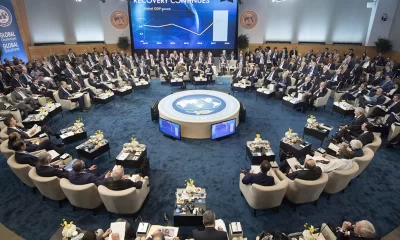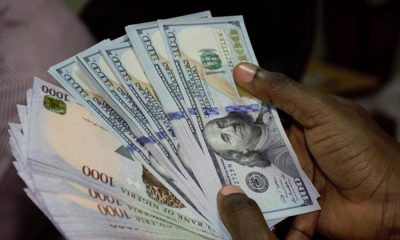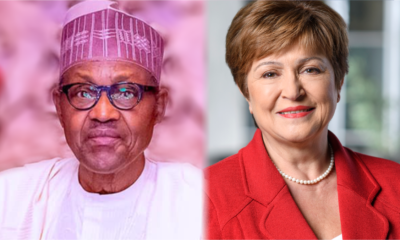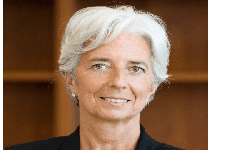NEWS
IMF: Fed Tightening May Squeeze Portfolio Flows to Nigeria, Others

A key question facing global investors today is what impact the US Federal Reserve’s monetary policy normalisation process will have on capital flows to emerging markets and other economies such as Nigeria that had enjoyed huge flows in recent times, a report by the International Monetary Fund (IMF) has stated.
The Central Bank of Nigeria continued to maintain a tight monetary policy regime in its quest to continue to attract portfolio inflows.
But the latest IMF’s model estimates showed that normalisation—raising the policy interest rate and shrinking the balance sheet—would likely reduce portfolio inflows by about $70 billion over the next two years, which compares with average annual inflows of $240 billion since 2010.
Shrinkage in the Fed’s $4.5 trillion balance sheet, which began in October, accounts for most of the impact on portfolio flows—defined as foreign purchases of emerging market stocks and bonds.
Reduced availability of foreign capital could make it more challenging for emerging market economies to finance their deficits and roll over maturing debt, the multilateral institution stated in the report obtained on its website on Monday. That is why the Fed should move gradually and communicate its plans clearly, they added.
The IMF’s latest ‘Global Financial Stability Report’ had shown that large-scale monetary accommodation had underpinned a significant portion of portfolio flows to emerging market economies since the global financial crisis.
“In particular, we estimate that about $260 billion in portfolio inflows since 2010 resulted from the “push” of unconventional monetary policy by the Federal Reserve, as opposed to domestic “pull” factors.
“The estimates are based on an econometric model adapted from a 2014 paper. The Fed’s large scale asset purchases, which $170 billion of the total as investors rebalanced portfolios toward higher-yielding emerging market assets. Downward shifts in market expectations for future Fed policy rates accounted for the remaining $90 billion.
“Our model results suggest that Fed monetary policy will continue to weigh on portfolio flows. We estimate that the reduction in the size of the Fed’s balance sheet will cut flows by $55 billion over the next two years.
“Flows could fall by an additional $15 billion if short-term interest rates were to rise in line with IMF forecasts. Our estimates assume that the US policy rate will rise to just under three per cent by the end of 2019, and that the tightening process will be orderly and will not take a toll on emerging market growth,” the report added.
It noted that a gradual pace of normalisation was therefore crucial to ensuring emerging markets’ ability to adjust to reduced inflows of funds.
Furthermore, it pointed out that even limited withdrawals of foreign capital could result in significant stress on emerging market borrowers if they were to occur over a relatively short period.
“For example, during the “taper tantrum” in 2013, when market participants interpreted Fed communication to signal that the central bank would reduce the pace of asset purchases sooner than expected, some $40 billion flowed out of emerging markets over a period of seven weeks as exchange rates depreciated sharply and asset prices declined.
“These findings underscore the need for the Fed and other advanced-economy central banks to change policy gradually. To ensure a smooth normalisation process, monetary authorities should provide well-communicated plans on unwinding their holdings of securities and guidance on any potential changes to their frameworks,” it added.
The Central Bank of Nigeria (CBN) had at its last Monetary Policy Committee (MPC) meetingretained Monetary Policy Rate (MPR) at 14 per cent.
The MPC had also retained the Cash Reserve Ratio (CRR) at 22.5 per cent, the Liquidity Ratio (LR) at 30 per cent and asymmetric corridor around the MPR at +200 and -500 basis points.
CBN Governor, Mr. Godwin Emefiele had explained that the committee in arriving at the decision, took into consideration several factors.
He said: “In arriving at its decision, the committee appraised potential policy options in terms of the balance of risks. The committee also took note of the gains made so far as a result of its earlier decisions, including the stability in the foreign exchange market and the moderate reduction in inflation and thus extensively deliberated the options regarding whether to hold, tighten or ease the policy stance.
“While tightening would strengthen the impact of monetary policy on inflation with complementary effects on capital inflows and exchange rate stability, it nevertheless could also potentially dampen the positive outlook for growth and financial stability.
“On the other hand, whereas loosening would strengthen the outlook for growth by stimulating domestic aggregate demand through reduced cost of borrowing, it could aggravate upward trend in consumer prices and generate exchange rate pressures.
“The committee also feels that loosening would worsen the current account balance through increased importation. On the argument to hold, the committee believes that key variables have continued to evolve in line with the current stance of macroeconomic policy and should be allowed to fully manifest.”


















